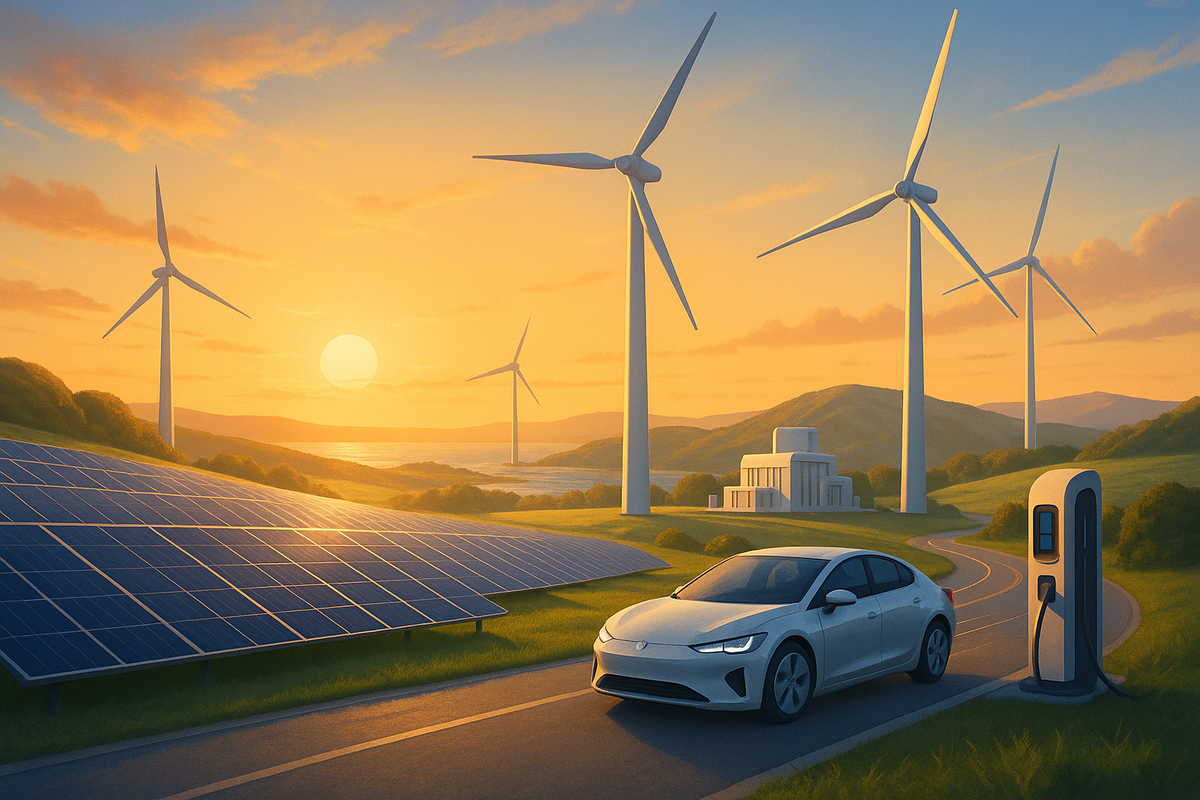Green Tech Revolution: Innovations Propel a Sustainable Future and Reshape Global Markets

The world is witnessing an unprecedented surge in sustainable and green technology, marking a pivotal moment in the global effort to combat climate change and achieve ambitious sustainability goals. From highly efficient solar cells and colossal wind turbines to revolutionary energy storage solutions, sophisticated carbon capture systems, and advanced electric vehicles, a wave of innovation is fundamentally reshaping industries and economies. These breakthroughs are not merely incremental improvements; they represent transformative steps towards a cleaner, more resilient energy future, promising to dramatically reduce carbon footprints and drive a new era of economic growth.
The immediate implications are profound, signaling a rapid acceleration away from fossil fuel dependency and towards a diversified, renewable energy landscape. Governments, corporations, and consumers are increasingly aligning their strategies and choices with these green advancements, creating a fertile ground for market disruption and the emergence of new leaders in the global economy.
A New Dawn for Clean Energy: What Happened and Why It Matters
The past few years have been characterized by a relentless pursuit of efficiency, scalability, and cost-effectiveness across the green technology spectrum. Each sector has seen remarkable progress, collectively contributing to a robust framework for a sustainable future.
In solar energy, the focus has shifted beyond traditional silicon panels. Breakthroughs in perovskite and tandem solar cells are pushing power conversion efficiencies to new heights, promising to surpass the theoretical limits of silicon alone. Companies are also innovating with bifacial solar panels that capture sunlight from both sides, and advancements in manufacturing processes are yielding more durable and cost-effective solutions. This matters because solar is now consistently the predominant new generating capacity added to grids globally, making electricity generation cleaner and more affordable.
Wind power is scaling up, quite literally. Turbine manufacturers like GE (NYSE: GE), Goldwind (HKG: 2208), and Mingyang Power are developing record-breaking turbines exceeding 13MW, with plans for even larger 18MW and 22MW models. Alongside this, floating offshore wind farms are opening up vast new areas for deployment in deeper waters with stronger, more consistent winds. Innovations in advanced blade designs using lightweight carbon fiber and direct-drive systems are further enhancing efficiency and reliability. These advancements are crucial for harnessing wind's immense potential, especially in offshore environments, and significantly reducing the cost of wind-generated electricity.
Energy storage solutions are the linchpin for integrating intermittent renewables into the grid and powering the electric vehicle revolution. While lithium-ion batteries continue to see enhancements in energy density, charging speed, and lifespan (with players like CATL and Tesla (NASDAQ: TSLA) leading the charge), the next frontier is solid-state batteries. Companies such as Samsung SDI (KRX: 006400) are developing solid-state batteries with significantly higher energy density and improved safety, promising to revolutionize EVs and grid storage. Flow batteries offer scalable, long-duration storage for grid applications, while research into sodium-ion and magnesium-ion alternatives aims for more abundant and cheaper materials. These innovations are vital for creating stable, resilient grids and extending the range and practicality of electric vehicles.
Carbon Capture and Storage (CCS) technologies are gaining traction as essential tools for decarbonizing hard-to-abate industrial sectors. Direct Air Capture (DAC), pioneered by companies like Climeworks and Occidental Petroleum (NYSE: OXY) with its STRATOS facility, captures CO2 directly from the atmosphere. Simultaneously, innovations in point-source capture by entities like Shell (NYSE: SHEL) and Mitsubishi Heavy Industries (TYO: 7011) are making it more efficient to trap CO2 from industrial emissions. Beyond storage, companies like CarbonFree are developing technologies to convert captured CO2 into valuable commercial products, creating a circular economy for carbon. CCS is critical for industries where emissions are difficult to eliminate, providing a pathway to net-zero.
The electric vehicle (EV) market is experiencing explosive growth, driven by continuous innovation. A groundbreaking development is structural battery composites, which integrate the battery's energy-storing function directly into the vehicle's load-bearing structure. Research from institutions like Chalmers University of Technology and KAIST, alongside exploration by Tesla (NASDAQ: TSLA), suggests this could increase EV range by up to 70% and significantly reduce vehicle weight. Coupled with advancements in silicon anodes for higher energy density and ultra-fast charging technology, EVs are becoming more competitive and accessible, accelerating the transition to sustainable transport.
Finally, emerging clean energy solutions are seeing a resurgence, particularly advanced nuclear technologies. Small Modular Reactors (SMRs), exemplified by NuScale Power (NYSE: SMR), are smaller, safer, and quicker to build than traditional reactors, offering decentralized, carbon-free baseload power. The "holy grail" of clean energy, nuclear fusion, is also making significant strides, with major research facilities like the National Ignition Facility and the Joint European Torus achieving critical breakthroughs. While commercial net energy from fusion is still projected for the early 2030s, the progress is undeniable. These advanced nuclear solutions offer reliable, 24/7 carbon-free power, complementing intermittent renewables and providing energy security.
These advancements collectively matter because they provide tangible, scalable solutions to the climate crisis, reduce reliance on finite fossil fuels, improve public health by reducing pollution, and enhance energy security and resilience globally.
Market Reconfiguration: Who Wins and Who Loses in the Green Shift
The green technology revolution is not just an environmental imperative; it's a monumental economic restructuring that will inevitably create clear market winners and losers. As investment pours into sustainable solutions, traditional industries face disruption, while innovative companies are poised for unprecedented growth.
Potential Winners:
Innovators and Early Adopters of cutting-edge green technologies stand to gain the most. This includes companies developing next-generation solar cells like perovskites, those pioneering solid-state batteries for EVs and grid storage (e.g., Samsung SDI (KRX: 006400), CATL), and developers of SMRs such as NuScale Power (NYSE: SMR). Their ability to bring efficient, cost-effective, and scalable solutions to market will secure significant market share.
Integrated Solutions Providers that offer comprehensive packages combining renewable energy generation with advanced storage and smart grid management will be highly valued. Companies like Tesla (NASDAQ: TSLA), with its solar, battery storage (Megapack), and EV ecosystems, exemplify this integrated approach. Similarly, utilities and energy companies that strategically invest in and deploy such integrated systems will thrive.
Material and Component Suppliers for these advanced technologies will see a surge in demand. This includes producers of specialized materials like carbon fiber for lighter, more efficient wind turbine blades and structural battery composites, as well as suppliers of critical minerals and chemicals for advanced battery chemistries.
Infrastructure Developers are essential enablers of the green transition. Companies focused on building out extensive EV charging networks, upgrading electricity grids to handle more renewable input, and constructing CO2 pipelines and storage sites for CCS projects will benefit substantially from the massive investment required in these areas. For instance, Occidental Petroleum (NYSE: OXY), through its Oxy Low Carbon Ventures, is heavily invested in CO2 infrastructure.
Regions with Favorable Policies and Investment will attract significant capital and foster innovation. Governments offering strong incentives, clear regulatory frameworks, and public funding for green technology R&D and deployment will become hubs for sustainable industries.
Potential Losers:
The Fossil Fuel Industry, particularly companies heavily reliant on the extraction, processing, and combustion of coal, oil, and natural gas, faces the most significant risk. Those that fail to diversify their portfolios into green technologies or transition their operations towards carbon capture and storage will likely see declining demand, stranded assets, and reduced profitability.
Outdated Technology Providers will struggle to compete. Manufacturers of less efficient solar panels, older-generation wind turbines, or conventional internal combustion engine (ICE) vehicles that do not adapt to newer, greener alternatives will find their products increasingly obsolete and uncompetitive in a market demanding sustainability and efficiency.
Companies Resistant to Sustainability Demands will face competitive disadvantages. Businesses that ignore stricter environmental regulations, consumer preferences for sustainable products, and investor pressure for ESG (Environmental, Social, and Governance) compliance risk losing market share, facing regulatory penalties, and experiencing reputational damage.
Regions with Insufficient Infrastructure will lag in the green transition. Areas lacking the necessary infrastructure for rapid EV charging, robust grid integration of renewables, or the capacity for large-scale carbon storage will hinder the adoption and deployment of green technologies, potentially missing out on economic opportunities and facing higher energy costs.
Overall, the market is undergoing a profound shift, rewarding agility, innovation, and a strong commitment to environmental sustainability, while penalizing inertia and reliance on carbon-intensive business models.
Broader Implications: A Paradigm Shift for Industry and Society
The advancements in sustainable and green technology extend far beyond immediate market impacts, signaling a fundamental paradigm shift that will ripple across industries, influence policy, and redefine societal norms. This green revolution is not merely about adopting new tools; it's about re-envisioning how we produce, consume, and interact with our environment.
These events fit squarely into the broader industry trend of decarbonization and electrification. Every sector, from transportation and manufacturing to agriculture and construction, is under pressure to reduce its carbon footprint. The innovations in EVs, renewable energy, and carbon capture provide concrete pathways to achieve this. The push for a circular economy, where resources are reused and waste is minimized, is also gaining momentum, with green technologies playing a crucial role in enabling more sustainable production and consumption cycles.
The ripple effects on competitors and partners are significant. Companies in traditional energy sectors are increasingly forming partnerships or acquiring green tech startups to diversify their portfolios. For example, oil and gas majors are investing in CCS projects or renewable energy ventures. Conversely, established green tech firms are finding new partners in logistics, finance, and IT to scale their operations and integrate their solutions more broadly. This fosters an ecosystem of collaboration and competition, driving further innovation.
Regulatory and policy implications are profound. Governments worldwide are responding to climate change imperatives with more stringent environmental regulations, carbon pricing mechanisms, and ambitious renewable energy targets. This creates a powerful tailwind for green technologies, driving investment and accelerating adoption. Incentives for EV purchases, subsidies for renewable energy projects, and tax credits for carbon capture are becoming commonplace, shaping market dynamics and investment decisions. The U.S., for instance, has numerous CCS projects under consideration, partly due to policy support.
Historically, major technological shifts, such as the industrial revolution or the digital age, have led to dramatic societal and economic transformations. The current green tech revolution bears similarities, with the potential to create millions of new jobs, stimulate vast amounts of private investment, and fundamentally alter geopolitical energy dependencies. The transition away from fossil fuels could empower nations rich in renewable resources, potentially reshaping global power dynamics. The rapid cost reduction in solar and wind power, mirroring the exponential growth seen in computing power (Moore's Law), suggests a similar trajectory of accelerated adoption and disruptive impact.
What to Pay Attention to Next: Navigating the Green Horizon
As the green technology revolution gains momentum, several key areas warrant close attention from investors, policymakers, and the public alike. The coming years will be critical in determining the pace and scale of this transformative shift.
In the short-term, watch for continued breakthroughs in battery technology, particularly the commercialization of solid-state batteries and further improvements in lithium-ion energy density and charging speeds. The deployment rate of ultra-fast EV charging infrastructure will also be a critical indicator of broader EV adoption. Additionally, monitor the progress of major CCS projects, especially DAC facilities, to assess their scalability and cost-effectiveness. The performance of new, larger offshore wind turbines will be key to unlocking deeper water wind resources.
For the long-term, the development and deployment of Small Modular Reactors (SMRs) will be crucial for providing reliable, carbon-free baseload power, complementing intermittent renewables. Keep an eye on the progress in nuclear fusion research, as any significant leap towards commercial net energy could be a game-changer. The integration of artificial intelligence and machine learning into green technologies, from optimizing grid management to enhancing turbine efficiency and predicting battery performance, will unlock further efficiencies and capabilities.
Potential strategic pivots or adaptations will be required across industries. Traditional automotive manufacturers must accelerate their transition to EVs, while energy companies need to continue diversifying into renewables and clean hydrogen. Technology companies will find new opportunities in developing software and hardware for smart grids, energy management, and sustainable manufacturing. Supply chain resilience for critical minerals and components for batteries and renewables will also be a significant challenge and opportunity.
Market opportunities will emerge in areas such as green finance, sustainable infrastructure development, and the circular economy. Investment in companies at the forefront of innovation in perovskite solar, structural battery composites, and advanced nuclear will likely yield significant returns. Conversely, challenges include navigating evolving regulatory landscapes, managing the intermittency of renewable energy sources, and ensuring equitable access to green technologies globally.
Potential scenarios and outcomes range from an accelerated transition to a fully decarbonized economy, driven by rapid technological advancements and strong policy support, to a more gradual shift, potentially hindered by economic headwinds, geopolitical instability, or slower-than-expected technological progress. The most likely scenario involves a continued, albeit uneven, acceleration of green tech adoption, with some sectors moving faster than others.
Conclusion: A Sustainable Future Takes Shape
The current wave of advancements in sustainable and green technology represents a profound turning point in humanity's relationship with the planet and its resources. From the efficiency gains in solar and wind power to the revolutionary potential of energy storage, carbon capture, electric vehicles, and advanced nuclear solutions, the tools to build a truly sustainable future are rapidly coming into being.
The key takeaways are clear: innovation is driving unprecedented progress, making green technologies more efficient, affordable, and scalable than ever before. This is creating significant market disruption, rewarding agile and forward-thinking companies while challenging those resistant to change. The broader implications point to a fundamental restructuring of industries, economies, and global energy dynamics, driven by a growing imperative for decarbonization and resilience.
Looking forward, the market for green technologies is poised for continued robust growth. Investors should watch for companies that demonstrate strong R&D capabilities, offer integrated solutions across the energy value chain, and are deeply committed to ESG principles. The ongoing development of breakthrough technologies like solid-state batteries, structural battery composites, SMRs, and particularly nuclear fusion, will define the next decade of the green revolution.
In the coming months and years, investors should pay close attention to policy developments, which will continue to shape market incentives and regulatory frameworks. Furthermore, monitoring the progress of large-scale deployment projects in offshore wind, CCS, and EV charging infrastructure will provide valuable insights into the pace of adoption. The green technology sector is not just a niche market; it is increasingly becoming the engine of global economic growth and the cornerstone of a sustainable future. The companies and nations that embrace this transformation most effectively will be the leaders of tomorrow.



